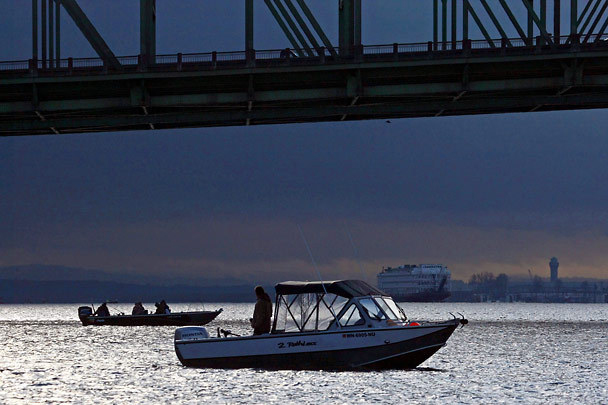There’s not likely to be much spring chinook salmon fishing in the lower Columbia River in April no matter how Washington and Oregon structure the season.
Figure on being done downstream of Bonneville Dam by about April 5, maybe April 8.
The bi-state Columbia River Recreational Fishery Advisor Group got a look at the spring chinook options on Wednesday. It’s not pretty because spring chinook headed for upstream of Bonneville Dam are forecast to number 141,400, down significantly from an actual return of 203,100 in 2012.
By the time all the management layers — Endangered Species Act restrictions, tribal/non-Indian catch balancing, buffers for forecast errors and sport-commercial sharing — are applied there are 5,010 upper Columbia-origin spring chinook available for lower Columbia sportsmen prior to mid-May.
The option most preferred by the recreational adviser group would have spring chinook fishing open daily for boaters upstream as far as Beacon Rock and for bank fishermen all the way to Bonneville Dam.
Biologist John North of the Oregon Department of Fish and Wildlife that season structure is projected to keep fishing open through April 5, a Friday. There would be 4,630 upper Columbia chinook taken plus 1,500 from the Willamette and other rivers for a total catch of 6,130.
The second most popular option was the same as the first, only fishing from a boat would be limited to downstream of Interstate 5. North said that is modeled to keep fishing open through April 8 with an overall catch of 7,070.
The option that limited boat and bank fishing to downstream of I-5 would extend the season through April 10 and catch 7,610 spring chinook.
Several of the advisers said they will gladly sacrifice a day or two of angling to allow boat fishing upstream of I-5, opening up many additional miles.
“I would prefer a quality fishery, compared to a combat fishery,” said Harry Barber, an advisory group member from Washougal.
When I-5 is the upstream boundary and the Willamette River turns muddy, thousands of boats jam in the clear water between I-5 and Caterpillar Island.
The longest season modeled limited all fishing to downstream of I-5 and switched from angling daily to Wednesdays-through Saturdays beginning March 24. That would extend to April 12.
Steve Watrous of Vancouver said sportsmen need to remember that for 30 years there was little or no spring chinook fishing in the Columbia River.
Commercial season — The commercial fleet has an allocation of just 1,135 upper Columbia spring chinook.
The spring chinook sharing ratio in 2012 was 50 percent for sportsmen, 45 percent for the commercials and 5 percent unallocated.
The Columbia River reforms adopted recently by the Washington and Oregon fish and wildlife commissions changed that to 65 percent sport and 35 percent commercial in 2013.
Tony Nigro of the Oregon Department of Fish and Wildlife said the gillnetters likely will get one day of spring chinook fishing in the lower Columbia this year, perhaps two at most.
Sturgeon fishing flap
Washington and Oregon have agreed to allow sturgeon retention in the lower Columbia for one additional season, then switch to catch-and-release only in 2014.
The population of legal-size sturgeon in the lower Columbia is projected to be 74,300 fish. The harvest rate has been cut yet again, this year to 13.6 percent.
That calculates to a harvest of 10,105 sturgeon, split 8,084 for sportsmen and 2,021 for the gillnetters.
Anglers in the estuary have an allocation of 4,042, the stretch between the Wauna power lines near Cathlamet and Bonneville Dam will get 2,021 sturgeon and the lower Willamette is due 1,733, said Brad James of the Washington Department of Fish and Wildlife.
Fishing seasons are expected to be similar to 2012, but a bit shorter.
What really has sportsmen irked is Oregon’s decision to adopt a one-sturgeon annual bag limit. Washington currently has a five-fish annual limit and will decide for 2013 in March.
Oregon’s one-fish limit does not significantly hurt guides and charter operators, while all but finishing private boat anglers.
“There’s no reason private boaters should be penalized so the guides and charters get a full season,” said Larry Swanson of Vancouver, an advisory group member. “I just think it is ridiculous.”
Watrous said to apply the limit fairly then guides should be limited to a total of four to six sturgeon for the year and charters to 16 (the seating capacity of their boats).
“I don’t see how anybody can pass the red-face test on this one,” Watrous said.
Nigro said the Oregon Fish and Wildlife Commission has made its decision on sturgeon for 2013. Guy Norman, regional director of the Washington Department of Fish and Wildlife, said concurrent regulations on the Columbia River are preferred, but stopped short of saying Washington will follow suit.
Kevin Kuhel, an advisory committee member from Milwaukie, Ore., said he does not believe in catch-and-release sturgeon seasons because repeated catch and release stresses the fish.
“Let’s catch and kill them and then get everybody off the water,” Kuhel said.
Washington and Oregon will meet at 10 a.m. Wednesday at the Sheraton Portland Airport Hotel, 8235 N.E. Airport Way to adopt Columbia River sport spring chinook rules. A commercial fishing plan also will be set.




